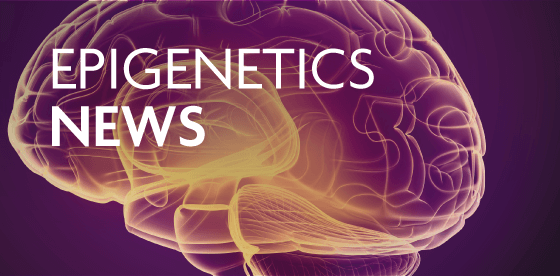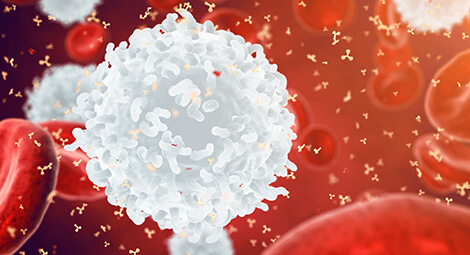<< Back to MOTIFvations Blog Home Page
H3Q5Ser & Happy Histones, New BRD Tools, ssChIC-Seq, Medusavirus Histones, & More Epigenetics News

May 7, 2019
The epigenetics field is moving quickly, hundreds of new papers are published every month, making it hard to keep up with the newest findings. We’re trying to make it a little easier for you to stay up-to-date in this exciting area by scouring the literature and bringing you short and easily digestible summaries of the most interesting and most impactful discoveries in epigenetics research each month.
This month we cover epigenetic serotonylation and “happy histones,” using epigenetics to better predict the outcomes of infants born prematurely, new tools to study bromodomain proteins, single-cell chromatin analysis with a new method called ssChIC-Seq, and the discovery of medusavirus, a large DNA virus that encodes its own full set of histones.
H3Q5Ser is a New Epigenetic Modification

Histone Serotonylation & Happy Chromatin
Serotonin is probably the most well-known neurotransmitter and many people think of it as the “happy chemical” because of its association with happiness and well-being. Although the main role of serotonin is to act as a neurotransmitter, transferring signals between neurons in our brains, and interestingly also between neurons in our gut where it acts to control intestinal movements, serotonin can also become covalently attached to proteins and alter their activity.
A recent paper in Nature demonstrated that serotonin is a novel modification of histone proteins. In particular, histone H3 is serotonylated on glutamine residue 5 on the N-terminal tail (H3Q5ser).
Interestingly, the H3Q5ser modification was primarily found in the presence of another histone modification, H3K4me3, which is one of the main epigenetic marks associated with active transcription, suggesting that H3Q5ser might also positively regulate gene expression.
The authors also identified that the enzyme tissue transglutaminase 2 could serotonylate histones containing the H3K4me3 modification.
The dual modification of histone tails containing both H3K4me3 and H3Q5ser (referred to as H3K4me3Q5ser) was most abundant in brain and gut tissues, the primary sites of serotonin production and the main places in the body where its effects are known to occur.
Functional studies showed that nucleosomes containing the dual H3K4me3Q5ser modifications were enriched in the euchromatic regions of the chromosomes that are generally being actively transcribed. Furthermore, histones containing the H3K4me3Q5ser modifications were preferentially bound by the general transcription factor complex TFIID, and mutational analyses using a version of histone H3 that could not be serotonylated suggested that histone serotonylation contributes to regulation of gene expression and cellular differentiation.
This study was important because of its demonstration that serotonin has other effects on biology than its primary role as a neurotransmitter. Although researchers have learned an incredibly large amount about epigenetics and gene regulation in general, it’s amazing to think about how much we still have yet to discover.
Reference: Farrelly, L.A et al. Histone serotonylation is a permissive modification that enhances TFIID binding to H3K4me3. Nature 567: 535-539. (2019)
Link
Using Epigenetics to Improve Premature Newborn Neurological Predictions

Premature birth of babies can be devastating to the families directly involved due to the long-term health care issues that are often experienced. However, improvements to medical diagnostic and treatment technologies have significantly increased the survival rates and prognoses of premature newborns. The long-term health of infants born prematurely varies significantly, and better methods are needed to predict which babies need which types of early interventions to give them the best chance for healthy lives.
In a recent issue of the journal Scientific Reports, a group of pediatric doctors and researchers published the results of their study on a cohort of infants born at less than 30 weeks after pregnancy (postmenopausal age <30 months). The goal of their research was to learn more about the epigenomics of preterm infants and learn whether epigenetic analyses could contribute to the health outcomes of these babies. The researchers investigated DNA methylation patterns on a genome-wide scale in buccal swab samples from the infants and also investigated their neurological behavior using the NICU Network Neurobehavioral Scale (NNNS).
The scientists were looking for regions of differential DNA methylation in the newborn DNA and they also estimated epigenetic age of the infants using the “epigenetic clock” developed by Steve Horvath.
The researchers started by stratifying the cohort of premature infants using the NNNS into 6 profiles and focused on two groups for most of their analyses, the most “optimal” profile and an “atypical” profile.
The overall DNA methylation profiles were not significantly different between the atypical group and other groups, but there were differential methylation levels at 29 individual CpG sites. Some of the genes likely regulated by these differentially regulated CpGs included PLA2G4E, TRIM9, GRIK3, and MACROD2, which have previously been associated with neurological structure and function, or with neurobehavioral disorders.
The infants in the optimal group had a slightly older epigenetic age, leading the authors to speculate that the epigenetic landscape can contribute to the health and prognosis of babies born prematurely.
As a conclusion, authors used DNA methylation statuses of different genes as molecular biomarkers, and when combined with epigenetic age analyses the researchers were able to link epigenetic profiles with behavioral measures in newborns. More work is clearly needed to make even stronger conclusions in the future, but this study highlights that the approach of using epigenetics for predictive tests is showing promise.
Reference: Everson, T.M. et al. Epigenome-wide Analysis Identifies Genes and Pathways Linked to Neurobehavioral Variation in Preterm Infants. Science Reports 9: 6322. (2019)
Link
New Tools to Study Bromodomain Inhibition & Uncover Novel Epigenetic Mechanisms

Bromodomains (BRDs) are a family of conserved protein regions that interact with other proteins that have acetylated lysine residues. Acetylated lysines are one of the most abundant and important groups of epigenetic modifications to histone proteins. Specifically, acetylation of lysine 27 on histone H3 (H3K27Ac) is a really hot histone modification because it is used to identify genetic regulatory elements such as enhancers and super-enhancers.
Because of the importance of lysine acetylation to epigenetic regulation of gene expression, and the altered regulation of this epigenetic mark observed during many cancers and other diseases, bromodomain inhibitors have emerged as a promising new class of therapeutic drugs in the past few years. Many pharmaceutical companies have invested significantly in BRD inhibitor programs with the hope of being able to specifically target the interactions of BRD-containing proteins with epigenetic modifications that are found in certain disease states.
However, there are still bromodomains that do not yet have potent inhibitors identified, highlighting the need for additional research to accelerate both basic biology studies and translational and clinical research programs.
In a recent issue of Nature Communications, a team of scientists from laboratories in Canada and Germany published their results on a set of 25 chemical probes, which are selective small molecule inhibitors that can potentially be developed into drugs, covering 29 human bromodomain proteins.
The chemical probes described in the paper are available to purchase or request online.
The researchers have also evaluated the selectivity and potency of these chemical BRD inhibitors using the BROMOscan assay and demonstrated the utility of the set identifying roles of BRDs in cellular processes and potential translational applications.
Bromodomains remain a promising family of epigenetic inhibitor targets and an improved toolbox to study their mechanisms in more detail will hopefully lead to the development of new and improved therapeutic molecules.
Reference: Wu, Q. et al. A chemical toolbox for the study of bromodomains and epigenetic signaling. Nature Communications 10: 1915. (2019)
Link
Single-Cell Chromatin Analysis with ssChIC-Seq

Improved technologies and techniques have made it possible for researchers to start answering biological questions at the single-cell level. Individual cells within a population in culture or in tissues are all different from each other, so to confidently correlate changes in epigenetic modifications with changes in gene expression it is important to look at cells individually rather than heterogeneous populations of cells.
Several genome-wide methods have been adapted for single-cell analysis, including RNA-Seq and ATAC-Seq. ChIP-Seq assays have been difficult to perform reliably with single cells due to unique complications of the ChIP workflow.
ChIP assays are particularly difficult with low sample amounts and single cells because the chromatin preparation and sonication steps are less efficient with low cell numbers, leading researchers to explore other sample preparation and chromatin fragmentation methods.
A recent research paper from a group of researchers led by Keji Zao´s laboratory at the NIH presents a novel protocol for single-cell genome-wide chromatin analysis that they termed single-cell chromatin immunocleavage sequencing (or ssChIC-Seq for short).
The ssChIC-Seq method is similar to the transposase-mediated TAM-ChIP assay developed by Active Motif but uses micrococcal nuclease (MNase) instead of the TsTn5 transposase used in TAM-ChIP. ssChIC-Seq targets MNase to a histone mark of choice by tethering the enzyme to an antibody specific for the histone modification of interest. The ssChIC-Seq method includes PCR amplification and library prep steps after the antibody-based enrichment, whereas the TAM-ChIP approach includes addition of the NGS library adapter sequences as part of the antibody enrichment step.
The researchers were able to reliably detect the histone modifications H3K4me3 and H3K27me3 in single blood cells using the ssChIC-Seq method and were able to use their data to cluster the cells into cell type-specific lineages. The robust data in this report suggest that the ssChIC-Seq method might be able to be developed further to investigate less abundant histone modifications and maybe even chromatin-remodeling factors or other DNA-binding factors like transcription factors.
Single-cell chromatin analysis methods like ssChIC-Seq are opening new doors for epigenetic profiling and other experimental approaches in the context of complex cell populations and tissues, and we’re excited to see what discoveries these new approaches will enable.
Reference: Ku, W.L. et al. Single-cell chromatin immunocleavage sequencing (scChIC-seq) to profile histone modification. Nature Methods 16: 323-325. (2019)
Link
Discovery of Medusavirus – A Large DNA Virus that Encodes its Own Full Set of Histones

The scientific research area of astrobiology explores things such as the origin of life in the universe, the very very early days of evolution, and whether life does (or can) exist in places other than Earth. This type of research sometimes involves studying the unique and varied life that exists at extreme conditions on Earth, such as in hot springs and underwater hydrothermal vents, because these conditions might be similar to those on other planets.
A team of researchers recently identified a novel virus isolated from a hot spring in Japan. The virus has a large (381 kbp) DNA genome that encodes at least 461 proteins. The called their newly-discovered virus “medusavirus” because of its tendency to seemingly turn the amoeba cells that it infects to stone through a process called encystment.
Many medusavirus genes share homology with genes present in the amoeba host cell, suggesting that the virus and the host may have co-evolved together. It’s intriguing to speculate that maybe the virus could be directing the evolution of the host cell for its own benefit.
Interestingly, the medusavirus encodes homologs of all 4 core histones (H2A, H2B, H3, and H4) as well as the linker histone H1, making it the first such virus discovered. It’s not clear yet whether the medusavirus packages its genome into nucleosomes using the virally-encoded histones, but the histones appear to be present at high enough levels that it would be a possibility. Alternatively, the histones encoded by the virus might be used to regulate the chromatin-mediated mechanisms of the host cell, representing a new way for viruses to re-program host cells for their benefit.
Viruses generally do not encode proteins that they don’t use, they’re very efficient replicating machines, so it seems likely that since these histone proteins encoded by the viral genome have survived evolutionary selection, they are likely important for the medusavirus lifecycle.
Not only are viruses important to study due to their role in human diseases, they are also useful model systems to study the regulation of gene expression and other biological processes in humans and other organisms. Viruses have evolved many tricks to improve replication and gene expression efficiency, so there's a lot that we can learn about ourselves by studying them.
It will be interesting to follow the discovery of medusavirus and other related viruses isolated from harsh environments to see what they can teach us about life on Earth, and potentially life in outer space.
Reference: Yoshikawa, G. et al. Medusavirus, a Novel Large DNA Virus Discovered from Hot Spring Water. Journal of Virology 93: e02130-18. (2019)
Link
<< Back to MOTIFvations Blog Home Page





